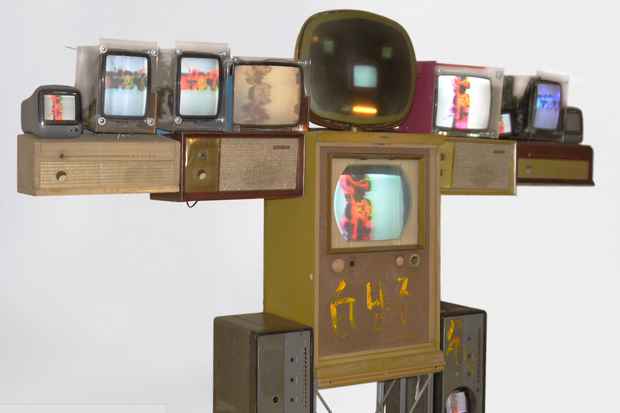Nam June Paik “The Legacy of Nam June Paik in The Post-Digital Age”
Shin Gallery

[Image: Nam June Paik "Big Shoulder" (1998) Mixed Media, Antique Cabinets, Televisions, Laser Disc Player, and Laser Disc 92 х 104 х 18 in. © SHIN GALLERY]
This event has ended.
In 1963, Nam June Paik introduced to the world an unprecedented way of realizing the potential of advanced technology as an art form. Paik’s groundbreaking solo exhibition, Exposition of Music-Electronic Television at Galerie Parnass in Wuppertal, Germany, presented the world’s first set of video art – Paik’s manually-altered television sets that distorted the reception of broadcast transmission. The Korean-born artist relentlessly pursued philosophical and technical limits of electronic machinery as an artistic medium until his death at the turn of the new millennium in 2003. As early as the 1960s, Paik began exploring the various media theories that were emerging with the onset of television. He had a precocious insight into the future of modern technology. In fact, in 1974, Paik predicted the invention and the aftereffects of the Internet in his proposal to the Rockefeller Foundation, “Media Planning for the Postindustrial Society – The 21st Century is Now Only 26 Years Away.” The artist wrote, “The building of a new electronic super highways will become an even huger enterprise – expenditure would be the same as about for a moon landing, except that the benefits in terms of by-products would be greater.” Although undoubtedly an avid enthusiast of digital technology and its revolutionary potential, Paik continually expressed mixed feelings of both hope and wariness towards its possible repercussions. On one hand, he envisioned a “Digital Utopia” where information and ideas can be exchanged freely and openly without cultural or spatial barriers. For instance, Paik’s well-known 1984 international satellite project, Good Morning Mr. Orwell¸ which aired simultaneously in France, Korea, and the United States and reached an audience of 25 million people, epitomized his celebratory attitude. On the other hand, Paik also believed that television can consume people’s lives and isolate them from their sense of reality. For this reason, the artist conceded that his purpose for making video art was to “liberate people from the tyranny of TV.” For him, manipulating and reconfiguring electronic devises to transform them into an art form was a way of mastering technology and creating a critical distance from it. Nearly a decade after the death of the artist and fourteen years past the new millennium, The Legacy of Nam June Paik in the Post-Digital Era seeks to commemorate the artist’s contributions and hopes to reignite a new dialogue of critically examining the effects of digital media in our post-modern society. This exhibition features Big Shoulder (1998), one work of Paik’s iconic robot series. This life-size sculpture stands eight feet tall and is composed of antique cabinets, televisions, laser discs, and disc players. The work is juxtaposed to a multi-channel sound installation, 14 Degrees of Separation (2014) – a new project by a contemporary digital artist, Esmeralda Kosmatopoulos. The latter work features fourteen speakers scattered throughout the gallery space that each recite an excerpt from Homer’s The Odyssey in different languages, which were translated by the online translation service, Bingo. Kosmatopoulos’ work speaks poignantly of the power and limitations of global communication at the age of the Internet. As an exhibition that looks back to venerate the extraordinary foresight of a pioneering video artist, it seeks to not only evoke nostalgia of the past that anticipated the post-digital era with fear and awe, but it also challenges the contemporary audience to ponder both the persisting and newly surfaced criticisms of advanced technology in the world today.
Media
Schedule
from July 09, 2014 to August 31, 2014
Opening Reception on 2014-07-16 from 19:00 to 20:30